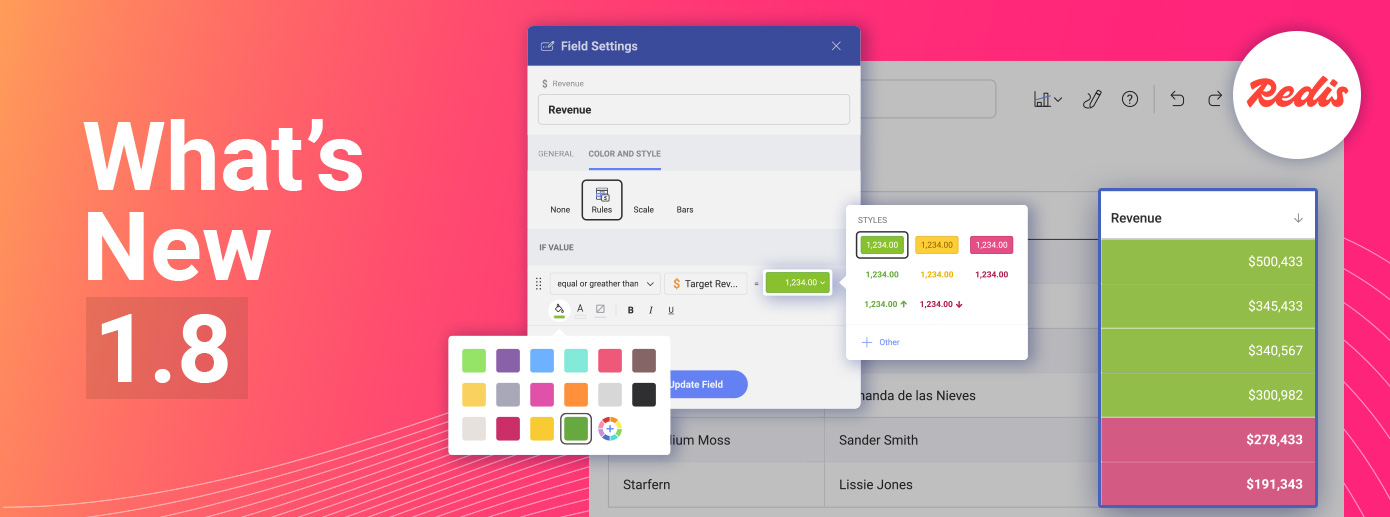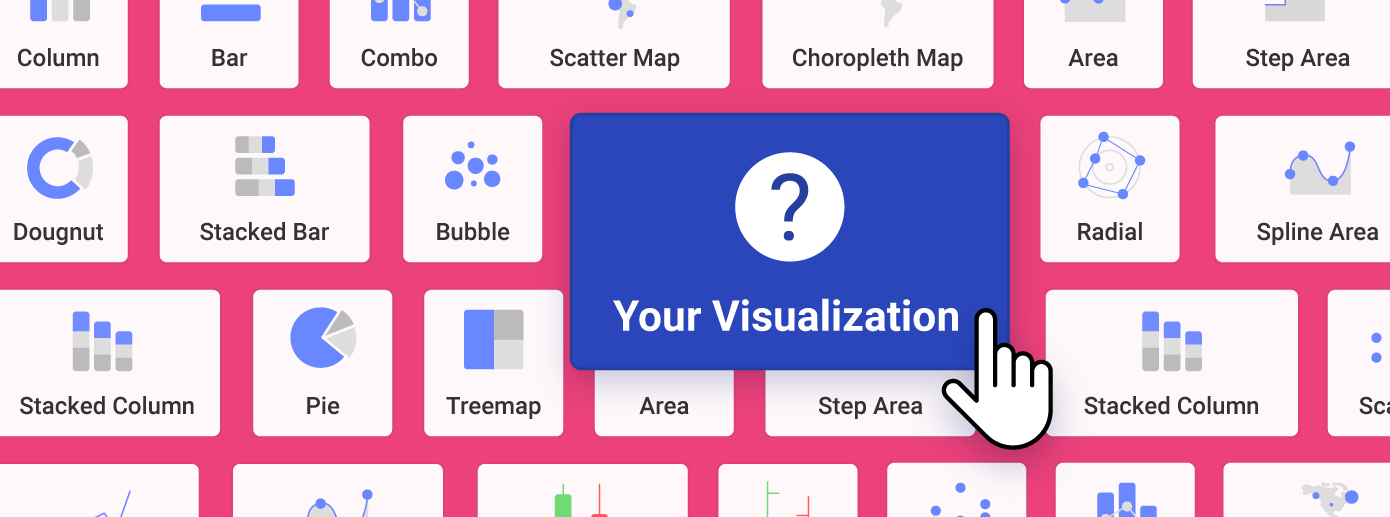
Stay up to date with Reveal
Reveal business intelligence blog gives you the latest embedded analytics trends, how-tos, best practices, and product news.

Reveal 1.7.3 is Here: Smarter Analytics, More Control, Better User Experience
Reveal Version 1.7.3 is live, bringing powerful new enhancements that put more control in the hands of developers and product teams.
Continue reading...
Reveal 1.8.1 Release: Conditional Formatting and Redis Cache Provider Now Available
Reveal 1.8.1 introduces two major upgrades: Conditional Formatting and the Redis Cache Provider. These updates make embedded analytics faster, clearer, and easier to scale. Conditional Formatting lets users apply rule-based color logic directly to charts, turning data into instant visual insight. The Redis Cache Provider delivers enterprise-level performance with distributed in-memory caching for real-time workloads. Together, these enhancements help developers and SaaS leaders build smarter, high-performing dashboards while keeping Reveal the standard for customizable and scalable embedded BI that delivers insight without complexity.
Continue reading...
Integrated Analytics Challenges: The Cost of Poorly Embedded Analytics in SaaS Products
Integration is one of the most expensive and underestimated challenges in SaaS development. Poorly embedded analytics slows delivery, inflates maintenance costs, and weakens adoption across the product lifecycle. Most issues come from fragmented data models, outdated BI tools, and reactive fixes that create long-term debt. Solving integration early through unified architecture, SDK-based embedding, and native UX reduces cost, improves scalability, and turns analytics into a reliable, built-in product capability.
Continue reading...
DIY Data Visualizations: How To Drive Adoption With Data
Generic dashboards fail SaaS teams by limiting adoption, slowing developers, and forcing users to rely on external tools. DIY data visualizations change that by embedding analytics directly into the product, making it flexible, engaging, and aligned with business needs. This shift drives adoption, reduces churn, and creates new revenue opportunities through customization and self-service. For SaaS leaders, the value is clear: analytics becomes a product capability, not an add-on. Reveal enables this with an embedded SDK, white-label control, and user-driven dashboards that scale with your product.
Continue reading...
Analytics as a Product: How to Turn Embedded Insights into Revenue
SaaS leaders face pressure to differentiate, grow revenue, and keep customers engaged. Product analytics offers a direct path to do all three. By embedding insights into their products, companies can create premium feature tiers, sell analytics as add-ons, and increase retention through daily reliance. Customers now expect self-service, branded, and intelligent dashboards as part of the experience. Meeting these expectations requires SDK-first integration, white-labeling, scalable pricing, and trusted connections to data. Platforms like Reveal enable product teams to embed analytics inside the product, turning it from a cost center into a revenue engine.
Continue reading...
How Embedded Analytics Can Reduce Time to Market for SaaS
In SaaS, speed to launch determines market success. Yet analytics often becomes the slowest part of the roadmap. Customers expect dashboard analytics at launch but developing that in-house can put a drain on resources which often leads to significant delays Embedded analytics solves this by integrating reporting directly into the product, cutting development cycles and improving adoption. Beyond launch, it supports retention, monetization, and advanced capabilities like AI. With SDK-first integration, self-service dashboards, white-label control, and predictable pricing, Reveal helps SaaS leaders reduce time to market and deliver analytics that scale with their product.
Continue reading...Analytics as a Product – How to Turn Embedded Insights into Revenue
SaaS leaders face pressure to differentiate, grow revenue, and keep customers engaged. Product analytics offers a direct path to do all three. By embedding insights into their products, companies can create premium feature tiers, sell analytics as add-ons, and increase retention through daily reliance. Customers now expect self-service, branded, and intelligent dashboards as part of the experience. Meeting these expectations requires SDK-first integration, white-labeling, scalable pricing, and trusted connections to data. Platforms like Reveal enable product teams to embed analytics inside the product, turning it from a cost center into a revenue engine.
Continue reading...
Looker Pros, Cons, and Looker Alternatives
Product leaders need analytics that scale with their app, not retrofitted BI tools. Looker offers strong visualizations and tight Google Cloud integration. But its use of LookML, iFrames, and user-based pricing makes it hard to embed in customer-facing products.
As SaaS teams grow, these constraints slow development, increase costs, and limit flexibility. That’s why more teams are replacing Looker with Reveal—an embedded analytics platform built for speed, scale, and predictable pricing.
This article breaks down where Looker fits, where it falls short, and why modern SaaS teams are moving on.

8 Steps to Embedded Analytics in FinTech Success
FinTech products compete on trust, compliance, and speed. Customers expect insights inside the product, not in external BI portals. That’s where embedded analytics in FinTech becomes critical. By embedding secure, branded dashboards directly into applications, SaaS teams meet regulatory demands, scale across tenants, and build adoption without slowing product roadmaps.
Continue reading...TEST TABLE STYLE EXPANDED
To help you make an informed choice, we analyzed and compared the 12 best embedded analytics platforms side by side, focusing on the features that matter most for ISVs and SaaS companies. Features compared: Platform Embedding Method White Label Capabilities Self-Service Dashboards Pricing Model Deployment Flexibility Data Source Compatibility AI Features Reveal SDK Full Yes […]
Continue reading...
5 Best White Label Analytics Platforms of 2025
We compared five leading white label analytics platforms across branding, integration, performance, scalability, data connectivity, user capabilities, and advanced features. Each platform offers a different balance of customization, speed, deployment flexibility, and pricing. This guide helps SaaS companies and ISVs identify which solution best fits their product requirements, customer expectations, and long-term growth plans.
Continue reading...

